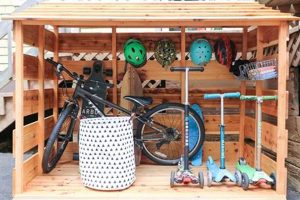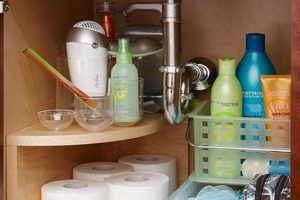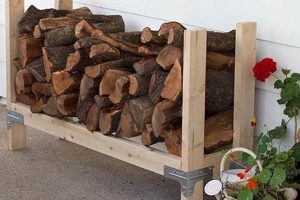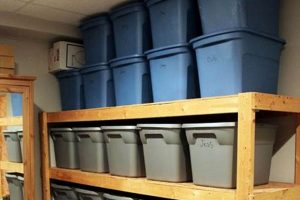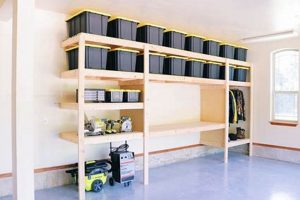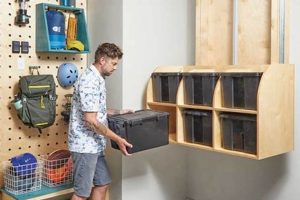The concept of creating customized solutions for organizing items within a pickup truck’s cargo area through do-it-yourself projects reflects a growing demand for efficient space management. These projects often involve constructing or adapting containers, drawers, or shelving systems to fit the specific needs of the truck owner and the types of cargo being transported. Examples include building wooden toolboxes, fabricating metal racks for equipment, or repurposing existing containers with modifications for secure attachment and weather protection.
Effective truck bed organization is crucial for maximizing available space, preventing damage to transported items, and enhancing overall vehicle utility. A well-organized truck bed improves accessibility to tools and equipment, reduces the risk of items shifting during transit, and contributes to a safer and more efficient work environment. Historically, improvised methods were commonplace, but the increasing availability of materials and online resources has fueled the rise of more sophisticated and personalized storage systems.
The subsequent sections will explore various strategies and construction approaches applicable to realizing effective pickup cargo area organizational systems, including material selection, design considerations, and safety precautions. These detailed explorations aim to provide the necessary foundation for creating practical and durable solutions.
Practical Advice for Pickup Cargo Area Customization
Effective development of organizational systems within a truck’s cargo area necessitates careful planning and execution. The following guidelines are intended to promote both functionality and durability in completed projects.
Tip 1: Prioritize Weather Resistance: Given the exposed nature of a truck bed, incorporate materials and construction techniques that withstand environmental elements. Waterproof coatings, sealed seams, and corrosion-resistant hardware are essential for longevity.
Tip 2: Secure Attachment is Paramount: Any storage solution must be securely fastened to the truck bed to prevent shifting during transit. Utilizing existing tie-down points, installing additional anchor points, or employing specialized mounting hardware are crucial considerations.
Tip 3: Optimize Space Utilization: Analyze the dimensions of the cargo area and the items to be stored. Design storage solutions that maximize available space by incorporating vertical storage, adjustable compartments, or modular components.
Tip 4: Material Selection Affects Durability: Choose materials appropriate for the intended use and load capacity. Wood, metal, and durable plastics each offer unique properties, and the selection should align with the demands of the application.
Tip 5: Plan for Accessibility: Consider the ease with which stored items can be accessed. Implementing sliding drawers, hinged lids, or removable containers can enhance user convenience and efficiency.
Tip 6: Emphasize Security: Implement locking mechanisms on storage compartments to deter theft and protect valuable equipment. Reinforced latches and tamper-resistant hardware can significantly improve security.
Tip 7: Consider Weight Distribution: Distribute the weight of stored items evenly throughout the truck bed to maintain vehicle stability and prevent overloading specific areas.
Adherence to these guidelines will improve the effectiveness and longevity of any customized truck bed organizational system, contributing to a more practical and efficient vehicle.
The following sections will discuss specific project examples and advanced techniques for realizing comprehensive cargo management solutions.
1. Material Durability
Material durability represents a critical factor in the successful implementation of customized cargo area organization within pickup trucks. The selection of appropriate materials directly impacts the lifespan, functionality, and overall effectiveness of “truck bed storage ideas diy.”
- Resistance to Environmental Factors
Materials used in truck bed storage solutions are constantly exposed to harsh environmental conditions, including rain, snow, sunlight, and extreme temperatures. The capacity to resist corrosion, UV degradation, and water damage is paramount. For example, untreated wood will quickly degrade, while powder-coated steel or marine-grade plywood offer superior protection against the elements. Consequently, selecting materials with inherent resistance to these factors ensures the long-term integrity of the storage system.
- Load-Bearing Capacity and Structural Integrity
Truck bed storage systems must withstand the weight of tools, equipment, and other cargo. The chosen materials should possess sufficient load-bearing capacity to prevent deformation, cracking, or failure under stress. For instance, lightweight plastics may be unsuitable for storing heavy items, while reinforced steel or heavy-duty wood can provide the necessary support. Proper material selection, therefore, directly affects the structural integrity and safety of the entire storage setup.
- Abrasion and Impact Resistance
The interior of a truck bed is subject to constant abrasion and impact from shifting cargo. Materials used for storage solutions must be able to withstand this wear and tear without significant damage. Diamond plate aluminum, for example, offers excellent abrasion resistance, while impact-resistant plastics can absorb shocks without cracking. The selection of abrasion and impact-resistant materials prolongs the aesthetic appeal and functional lifespan of the storage system.
- Chemical Resistance
Truck beds are often exposed to various chemicals, including oil, gasoline, cleaning solvents, and road salts. The materials used in storage solutions should be resistant to these substances to prevent degradation, staining, or other forms of damage. Certain plastics and coatings offer superior chemical resistance compared to untreated metals or porous materials. The consideration of chemical resistance ensures that the storage system remains functional and aesthetically pleasing despite exposure to potentially damaging substances.
The combined effect of environmental resistance, load-bearing capacity, abrasion resistance, and chemical resistance dictates the overall durability of cargo area organizational systems. Selecting materials that adequately address these factors is crucial for maximizing the value and longevity of any “truck bed storage ideas diy” implementation.
2. Secure Mounting
The effectiveness of “truck bed storage ideas diy” hinges significantly on secure mounting. This aspect ensures that any storage solution remains firmly anchored within the truck bed, mitigating the risk of shifting, damage, or loss during transit. The absence of secure mounting directly translates to potential hazards, including damage to the vehicle, the storage unit itself, and the cargo being transported. For instance, a toolbox not properly secured can become a projectile in the event of sudden braking or a collision, presenting a severe safety risk to both the driver and other vehicles on the road. Therefore, secure mounting is not merely a convenience but a fundamental safety requirement in any truck bed storage system.
Several methods can achieve secure mounting, each offering varying degrees of effectiveness and complexity. Utilizing existing factory tie-down points is often the simplest approach, involving the use of straps, chains, or specialized fasteners to connect the storage unit to the vehicle’s pre-installed anchor locations. For heavier or more permanent installations, drilling and bolting directly to the truck bed may be necessary, requiring careful consideration of the vehicle’s structural integrity and the potential for corrosion. Additionally, the use of bed liners or mounting plates can provide a stable and protected surface for attaching storage solutions, distributing the load and preventing damage to the underlying metal. A well-executed mounting strategy not only prevents movement but also ensures that the storage unit can withstand the forces exerted during normal driving conditions, including acceleration, deceleration, and cornering.
In conclusion, secure mounting is an indispensable component of any successful “truck bed storage ideas diy” implementation. It directly impacts the safety, durability, and overall functionality of the storage solution. Neglecting this critical aspect can lead to potentially hazardous situations and costly damage. Prioritizing robust and appropriate mounting techniques is paramount to realizing the full benefits of a customized cargo management system within a pickup truck.
3. Space Optimization
Space optimization, within the framework of truck bed customization, represents a primary objective. Maximizing the usable volume of the cargo area through strategic design and construction directly enhances the utility and efficiency of the vehicle. This concept goes beyond simply adding containers; it involves a careful consideration of available dimensions and the specific storage needs of the user.
- Vertical Space Utilization
Exploiting vertical space is crucial in truck beds, as the horizontal area is often limited by the wheel wells and bed width. Implementing shelving units, tiered drawers, or overhead racks allows for the storage of items that would otherwise occupy valuable floor space. For example, a ladder rack positioned above the bed floor creates storage for long items, freeing up the bed for other equipment. This approach effectively multiplies the available storage volume without increasing the footprint of the storage solution.
- Custom-Fitted Compartments
Generic storage containers often waste space due to their standardized dimensions. Constructing custom-fitted compartments tailored to specific tools or equipment minimizes unused volume. Creating a segmented drawer system for frequently used hand tools, with each tool having a designated space, eliminates wasted space and promotes organization. Such tailored solutions ensure that every available inch is utilized effectively.
- Modular Design Systems
Employing modular components allows for flexible configuration and reconfiguration of the storage system. A modular design enables the user to adapt the storage layout as their needs evolve, adding or removing components as required. This approach prevents the storage system from becoming obsolete and ensures that it continues to meet the changing demands of the user. For example, a system of interlocking bins and drawers can be easily rearranged to accommodate different types of cargo.
- Concealed Storage Solutions
Integrating storage compartments that are hidden beneath the bed floor or within the side walls of the truck bed allows for the discreet storage of valuable items, safeguarding them from theft and the elements. Designing a false floor with hidden compartments beneath provides a secure space for storing tools or equipment while maintaining a clean and uncluttered appearance. This strategy maximizes space while simultaneously enhancing security.
The integration of vertical space utilization, custom-fitted compartments, modular design systems, and concealed storage solutions demonstrates the multifaceted nature of space optimization in truck bed customization. These approaches, when combined effectively, can transform a standard truck bed into a highly organized and efficient cargo management system, maximizing usable volume and improving overall vehicle utility.
4. Weather Resistance
Weather resistance represents a critical design parameter within the context of “truck bed storage ideas diy.” The open nature of a pickup truck bed exposes storage solutions to a range of environmental elements, including precipitation, sunlight, temperature fluctuations, and airborne debris. Consequently, the material selection and construction techniques employed directly influence the longevity and functionality of any customized storage system. Failure to adequately address weather resistance leads to accelerated degradation, compromised structural integrity, and potential damage to stored items. For instance, a storage box constructed from untreated wood will warp and rot when exposed to moisture, while metal components lacking a protective coating will succumb to corrosion. The cause-and-effect relationship is evident: exposure to the elements without adequate protection inevitably results in diminished performance and premature failure.
The practical application of weather resistance principles involves several key considerations. Material selection should prioritize inherently resistant options, such as marine-grade plywood, powder-coated steel, or durable polymers. Furthermore, construction techniques must incorporate features that prevent water intrusion, such as sealed seams, overlapping joints, and properly installed drainage systems. Coatings and sealants play a crucial role in providing an additional layer of protection against moisture, UV radiation, and chemical exposure. Consider a scenario where a DIY truck bed drawer system is designed with overlapping drawer faces and a weather-stripping seal around the perimeter; this significantly reduces the ingress of water and dust, protecting the contents from damage. Attention to detail in these areas translates to a more robust and reliable storage solution.
In summary, weather resistance is not merely an optional feature but an essential component of successful “truck bed storage ideas diy.” It directly impacts the lifespan, functionality, and overall value of the storage system. Addressing the challenges posed by environmental exposure requires a comprehensive approach, encompassing careful material selection, appropriate construction techniques, and the diligent application of protective coatings. By prioritizing weather resistance, individuals can create customized truck bed storage solutions that withstand the rigors of outdoor use and provide years of reliable service.
5. Accessibility
Accessibility, within the domain of DIY truck bed storage solutions, represents a key determinant of practicality and user satisfaction. The ease with which stored items can be retrieved and returned significantly impacts the efficiency and effectiveness of the entire storage system. A well-designed system prioritizes convenience without compromising security or space optimization.
- Reach and Ergonomics
The physical reach required to access stored items is a primary consideration. Deep or awkwardly positioned compartments necessitate excessive reaching, potentially leading to strain or injury. Solutions that bring stored items closer to the user, such as sliding drawers or pull-out shelves, enhance ergonomics and reduce physical exertion. For example, a drawer system positioned at waist height allows for easy access to tools without requiring the user to bend or kneel. This directly translates to improved efficiency and reduced risk of injury during use.
- One-Handed Operation
Situations often arise where users need to access storage compartments with only one hand available, whether due to carrying other items or maintaining balance. Storage solutions that facilitate one-handed operation, such as latches and lids that can be opened and closed with a single hand, improve usability. Implementing gas struts to assist in lifting heavy lids allows for controlled and effortless opening, even when the user’s other hand is occupied. This is particularly important in professional settings where speed and efficiency are paramount.
- Visibility and Organization
Clear visibility of stored items streamlines the retrieval process. Poorly lit or disorganized compartments necessitate extensive searching, wasting time and effort. Implementing interior lighting, transparent containers, or labeled compartments improves visibility and enables users to quickly locate desired items. A toolbox with clearly labeled drawers containing specific tools, for instance, eliminates the need to rummage through a jumbled assortment, saving valuable time and improving overall productivity.
- Security Considerations
Accessibility must be balanced with security. Readily accessible storage compartments may be vulnerable to theft or unauthorized access. Integrating locking mechanisms and tamper-resistant hardware enhances security without unduly compromising accessibility. A lockable drawer system, for example, provides a secure storage solution while still allowing for quick and easy access for authorized users. Finding the optimal balance between accessibility and security is crucial in ensuring both convenience and protection.
These facets, when collectively addressed, contribute to a highly accessible and user-friendly truck bed storage system. Prioritizing reach and ergonomics, one-handed operation, visibility and organization, and security considerations ensures that the storage solution not only maximizes space and protects cargo but also enhances the overall efficiency and convenience of the vehicle.
Frequently Asked Questions
The following questions address common inquiries regarding the design, construction, and implementation of customized storage solutions within pickup truck cargo areas. The intent is to provide concise and informative responses to assist individuals in making informed decisions about their storage systems.
Question 1: What factors should be considered when selecting materials for a DIY truck bed storage system?
Material selection requires careful assessment of durability, weather resistance, load-bearing capacity, and cost. Steel offers strength but is susceptible to corrosion without proper coating. Wood, particularly marine-grade plywood, provides a balance of strength and weather resistance, but requires sealing. Polymers are lightweight and corrosion-resistant but may lack the strength of metal. The selection should align with the intended use and budget.
Question 2: How can a truck bed storage system be securely attached to the vehicle to prevent shifting during transit?
Secure attachment is paramount for safety. Utilizing existing factory tie-down points with appropriate straps or fasteners is a common method. Drilling and bolting directly to the truck bed offers a more permanent solution but requires careful consideration of the vehicle’s structure. Mounting plates or bed liners can provide a stable base for attachment and distribute the load. Regular inspection of mounting hardware is recommended.
Question 3: What are some effective strategies for maximizing storage space within a truck bed?
Vertical space utilization is key. Implementing shelving units, tiered drawers, or overhead racks allows for efficient use of available volume. Custom-fitted compartments tailored to specific tools or equipment minimize wasted space. Modular design systems offer flexibility and adaptability. Concealed storage solutions provide secure and discreet storage options.
Question 4: How can a DIY truck bed storage system be designed to withstand exposure to the elements?
Weather resistance requires a multifaceted approach. Select materials inherently resistant to moisture, UV radiation, and temperature fluctuations. Employ construction techniques that prevent water intrusion, such as sealed seams and overlapping joints. Apply protective coatings and sealants to vulnerable surfaces. Implement drainage systems to prevent water accumulation.
Question 5: What measures can be taken to improve the accessibility of items stored within a truck bed storage system?
Prioritize reach and ergonomics by positioning frequently used items within easy reach. Implement sliding drawers or pull-out shelves to bring stored items closer to the user. Improve visibility with interior lighting and labeled compartments. Facilitate one-handed operation with appropriately designed latches and lids.
Question 6: How can the security of a DIY truck bed storage system be enhanced to prevent theft?
Integrate locking mechanisms on storage compartments, using robust latches and tamper-resistant hardware. Consider concealed storage solutions to deter opportunistic theft. Install an alarm system that triggers upon unauthorized access. Park the vehicle in well-lit and secure areas when possible.
The successful implementation of “truck bed storage ideas diy” hinges on addressing these factors. Careful planning and execution, with a focus on durability, security, and accessibility, will result in a functional and valuable addition to any pickup truck.
The subsequent sections will provide real-world examples and advanced customization techniques.
Conclusion
The preceding exploration of “truck bed storage ideas diy” underscores the multifaceted nature of effective cargo management within pickup trucks. Successfully executed projects require a careful balance of material selection, construction techniques, security measures, and accessibility considerations. Neglecting any of these critical elements compromises the utility and longevity of the storage solution.
The ongoing demand for customized cargo management solutions suggests a continued evolution of “truck bed storage ideas diy,” driven by innovation in materials, design, and security technology. Prospective constructors are advised to carefully assess their individual needs and vehicle specifications prior to commencing any project to ensure optimal outcomes.


